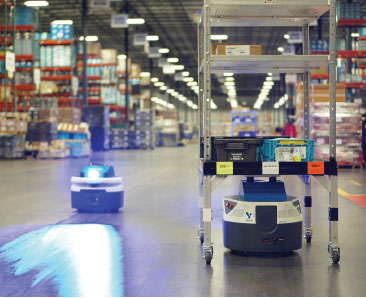- By Lynn DeRocco
- Workforce Development
Summary
Cobots, shorthand for collaborative robots, are coming to a factory near you, if they are not there already. These autonomous helpers are designed to work alongside humans to increase production, and to do so safely. But amid concerns that they will eliminate human jobs, cobots are now being promoted as a sort of compassionate technology. For instance, on a recent Cheddar Innovates broadcast, Tom Bianculli, chief technology officer for Zebra Technologies, said that cobots can reduce the miles walked by a warehouse worker from 12 or so miles a day to about three miles. He stated that using cobots could be about “having empathy for that worker, increasing their job satisfaction, and improving efficiency of the operation all around—a win-win.”
So, it seems that the future of humans collaborating with robots is meant to be one that workers feel good about, not threatened by. In factories, warehouses, and distribution centers, they are being used to literally lift the load that employees have had to carry. “A robot can do what it does best, which is transport, the movement of goods, and the human worker can do what it does best, which is the articulation, the actual picking of goods,” said Bianculli.
The goal is “deploying those technologies together, where the robot can autonomously navigate an environment and [a worker is] able to take a picked order, put it in a bin, and then bring that over to where it needs to be shipped,” he said.
Of course, like human workers, cobots come in a wide range of types, and they will be able to do more complex tasks with new innovations, especially in conjunction with other available platforms and technologies. A perfect example is what we are seeing in the medical field—cobots being specialized for medical instrument manufacturing while patient care is left to medical professionals, with their education, expertise, and ability to make critical, informed decisions.
Bianculli’s position corroborates this: “One statistic says 50 percent of work can be automated, but less than 10 percent of jobs can be automated more than 90 percent.” He adds that while tasks within a workflow can be automated, automating a complete workflow end to end is not likely.
When asked about the outlook for cobots in the manufacturing and logistics markets, Bianculli cited three factors that contribute to their adoption:
- shortage of labor
- creation of new types of cobots
- “need for speed.”

Like human workers, “upskilling” is possible for these types of co-workers, too. Robots are becoming smarter every day thanks to advances in technologies such as machine learning and artificial intelligence. As new cobots are designed to perform additional functions, factories and plants will have few reasons not to invest in them, and employees will likely come to appreciate the helping hands, even if they are robotic.
Reader Feedback
We want to hear from you! Please send us your comments and questions about this topic to InTechmagazine@isa.org.


